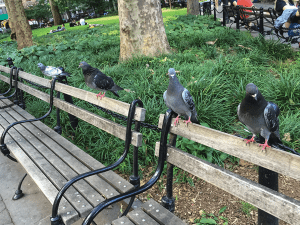 Spring feels in full swing. While that may not be good in some ways, plants and animals are ramping up their libidos. All manner of species display virility as spring progresses, but a common species often overlooked, is strutting about right at our feet. Call them pigeons, Rock Pigeons, Rock Doves, or rats with wings, they’re far from boring and they share our most urban Capitol Hill blocks happily.
Spring feels in full swing. While that may not be good in some ways, plants and animals are ramping up their libidos. All manner of species display virility as spring progresses, but a common species often overlooked, is strutting about right at our feet. Call them pigeons, Rock Pigeons, Rock Doves, or rats with wings, they’re far from boring and they share our most urban Capitol Hill blocks happily.
The pigeons we see on an almost daily basis, as common as House Sparrows, American Crows, European Starlings, and Glaucous-winged Gulls in the quintet of urban birds, are all ancestors of the Rock Pigeon or Rock Dove, Columbia livia. No matter their coloration, all these birds are feral descendants of birds brought to the Americas as pets and food as early as the 1600s, while successive escapes bolstered their population and variety. Their original wild population, spans from Europe through North Africa, and into Asia. With an appreciation for ledges and cliffs, they’ve adapted wholly to our built environment. Pigeons happily crowd ledges, roof tops, and attics, calling many a ledge on buildings of Broadway, Pike and Pine, First Hill, and downtown home.
From Mike Tyson to Charles Darwin, people have seen beauty in these aerial acrobats and gentle vocalists. Pigeons in their many varied forms, appear in Darwin’s On the Origin of Species and were central in helping him develop his theory. As with dogs, selective breeding has sussed out umpteen mutations of color and shape. Natural variation existed in the wild populations of course, but feral populations have muddied human breeding with sheer numbers, and we find ourselves looking at birds looking more and more like their ancestors. Besides, being bright white in a flock of gray, having decorative feathers that block vision, or having an odd tendency to tumble in the air aren’t terribly adaptive traits.
Take a second to watch your average city pigeon. In the vast majority, you find attractive shades of bluish gray, two black bands on the wings, and purplish green sheen on the neck and throat. These are the general colors of the nominate race of wild Rock Pigeons. Male birds are ever so slightly larger and have more extensive sheen. To most, the sexes look alike, but male birds stand out this time of year in behavior.
Pigeons can breed much of the year in mild climates, but as daylight lengthens hormones surge. Almost everyone has seen the comical courtship display of a puffed up male pigeon. Like many animals, humans included, they lose grip on reality, puff up their chests, and pursue their hopeful mate endlessly (while all she wants to do is eat bread crumbs). This can go on right at your feet while you wait for the bus, or on a precarious ledge where the pursued female may well be pushed off by her overzealous courtier. The desired result of this strutting, is copulation, an awkward balancing act for a brief cloacal kiss. Yet, unlike some birds, the pair is relatively monogamous. The male chooses a worthy nest site and stays with his mate throughout young rearing (he also coos incessantly to attract a mate to his site, imagine living next to the recording below on loop right outside your window).
Pigeons get a bad rap. They seem dirty, but if anything that’s because of city living, not poor hygiene. Yes, unlike some birds, they don’t take their young’s feces away from the nest, adding a veneer to roosting sites. This has worked for pigeon kind longer than humans have been raising them, so who are we to judge? Yes, contact with their droppings has proven a zoonotic vector. But shouldn’t common sense clearly guide us away from most anything’s poop anyway? These problems are easily avoided by restricting where Rock Pigeons roost, which most cities have figured out just fine.
Pigeons can also capture the imagination. Their spectacular flying abilities, allowing escape from swift predators like Peregrine Falcons, are a beauty to behold circling across city blocks. Pigeons have been heroes, saving lives by carrying messages across enemy lines during World War II with innate homing abilities. Organizations, books, and much research are devoted to pigeons. And while they may not be the smartest birds on the block, they’re successful while not edging out our native species. I simply enjoy them because their antics add a humorous note to a less noteworthy day about the Hill.
About Pigeon Patrol:
Pigeon Patrol Products & Services is the leading manufacturer and distributor of bird deterrent (control) products in Canada. Pigeon Patrol products have solved pest bird problems in industrial, commercial, and residential settings since 2000, by using safe and humane bird deterrents with only bird and animal friendly solutions. At Pigeon Patrol, we manufacture and offer a variety of bird deterrents, ranging from Ultra-flex Bird Spikes with UV protection, Bird Netting, 4-S Gel and the best Ultrasonic and audible sound devices on the market today.
Voted Best Canadian wholesaler for Bird Deterrent products four years in a row.
Contact Info: 1- 877– 4– NO-BIRD (www.pigeonpatrol.ca)

